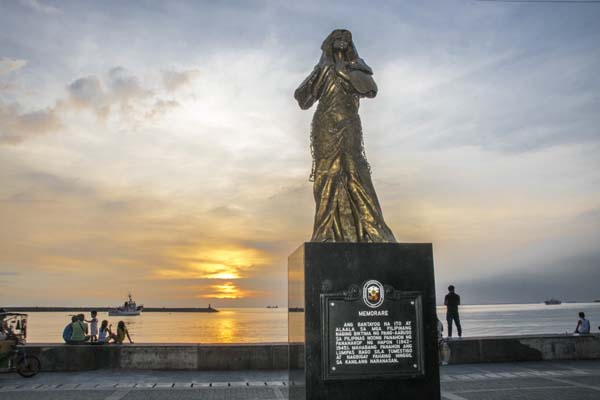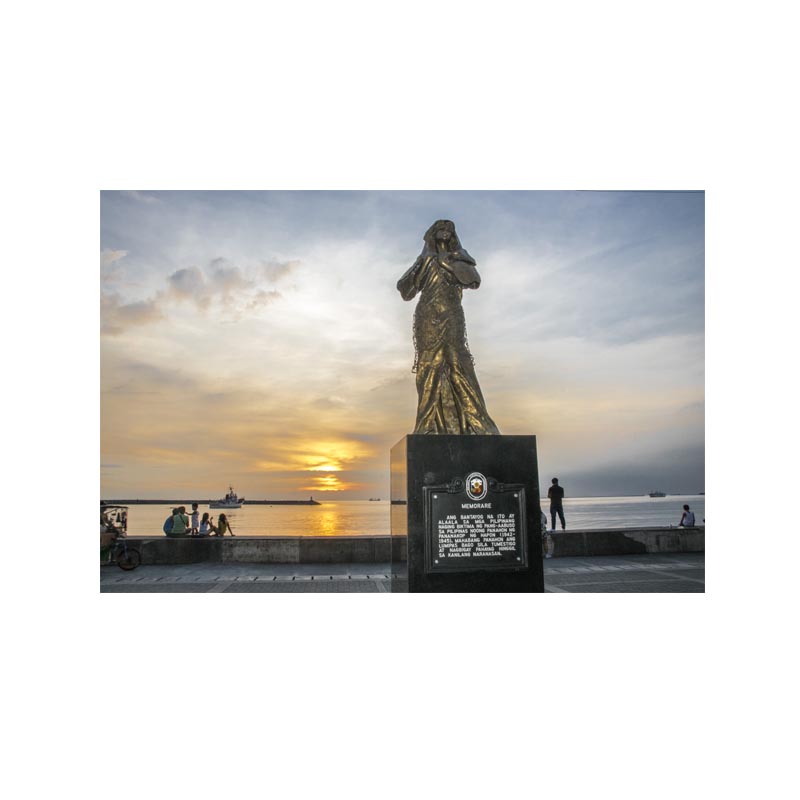
The support I got from various sectors for my position was overwhelming. Most of the responses from a number of Tsinoy and Filipino organizations and media groups echoed the editorial of the Manila Standard on Dec. 26: “Let the statue stand to tell everyone this part of history must not be forgotten.” And I concluded in my letter the position that it is a wiser and more prudent decision to let the statue be.
Queries about the statue
The statue was commissioned by a Tsinoy organization, Tulay Foundation, headed by the late Manuel Chua. He died without seeing the fruition of his dream to put up a memorial to remember the victims of the Japanese war but most especially, the women who suffered such violence and humiliation. The striking and realistic statue was done by artist Jose Dionas F. Roces. He finished it for some time already but it took the Foundation a long time to get all the necessary permits from various government agencies.
“The Japanese officials said that the issue on comfort women is a very big and serious issue in their country, China and Korea,” said a letter to the National Historical Commission of the Philippines and the city of Manila. It was signed by Milicent Paredes, the Asia-Pacific Division head, Department of Foreign Affairs. “They said they regret that despite the strong ties between the Philippines and Japan, a comfort woman statue has been suddenly erected in Manila.”
The DFA and the mayor’s office in turn asked NHCP for background information on how and why the statue was put up.
In my response to DFA secretary Alan Peter Cayetano and Manila Mayor Joseph Estrada, I stated that the statue “serves to remind humanity that violence against women is unacceptable any time and under any circumstances. It also serves as a reminder of the women who suffered and to pay tribute to their courage and resilience.” Likewise, I said, it is pro-forma for the Japan Embassy to protest, otherwise, it would not be doing its job. But, it is for our own government to defend our position. Japan will respect us more if we stand our ground.
Likewise, political scientist Lucio Pitlo III holds that good relations with Japan should not come at the expense of forgetting history and disregarding those who have suffered under Japanese occupation. Pitlo, who teaches at Ateneo de Manila University, asked Japan to sincerely own up for its past mistakes and refrain from applying pressure on countries simply commemorating part of their history. This, he says, is how Japan can become a normal power and play greater formal roles in the international system.
Objections
Supposedly, a group of Philippine travel agencies appealed to the city of Manila and the NHCP to remove immediately the statue of the Filipino Comfort Woman. This act will allay the negative reactions coming from travel agencies handling the Japanese tourist market as well as Japanese nationals and Filipinos living in Japan who might feel uneasy about their ties to their host communities.
Robert Lim Joseph, chairman of the National Independent Travel Agencies and was appointed as tourism consultant of the DOT in July 2016, said the organizations’ members have been receiving negative reactions to the Comfort Woman statue.
But a random check with some travel agencies affiliated with NITAS said they have not received any adverse reactions so far and were even unaware of the issue. They likewise believe having a comfort woman statue in Manila will not impact Japanese tourists’ decisions whether to visit the Philippines.
Some members of business groups likewise voiced concerns that the statue may affect Philippines-Japan relations and Japanese investments.
Pitlo, writing for Rappler commented: “Over time, Japan’s soft power, investments and overseas aid softened the position of most Southeast Asian countries, including the Philippines. Postwar Japan emerged as one of the Philippines’ largest donors, investors and trade partners. This economic dimension contributed in downplaying wartime grievances.
“But the experience of Korea and China suggests that robust economic interaction need not come at the expense of forgetting the past and denying justice for wartime victims. China and Korea are major trade partners of Japan despite the comfort women issue remaining a thorn in the complicated relations. China remains the largest source of imports for Japan and constitutes Japan’s second biggest export market after the (United States). South Korea, on the other hand, is the fourth largest import source of Japan and is Japan’s third largest export market.
“This principled position accords the governments of China and Korea the dignity and esteem in the eyes of their own people, as well as of Japan. It is no wonder that Korea and China obtained enormous wartime compensation and economic concessions from Japan.”
These points were emphasized by Pitlo in his article published by Rappler last Dec. 26.
Downplaying history and revisionism
Former Japanese Prime Minister Junichiro Koizumi in 2002, wrote a personal letter apologizing to the comfort women. He said that the involvement of the Japanese military in the issue of comfort women during the war was “a grave affront to the honor and dignity of large numbers of women.”
Korea and China protested that Koizumi’s personal apology is not enough, even if he is prime minister.
For the Philippines, said M. Evelina Galang, what the comfort women and their advocates want is the Japanese government’s acknowledgment and apology. “A personal apology is not the same thing as legislation from the Japanese government declaring their remorse over these crimes against humanity,” said Galang, a US-based Filipina who has written extensively on the plight of Filipina comfort women and author of the book Lola’s House: Women Living with War.
Some Japanese in fact describe “comfort women” as “prostitutes” who serviced the Japanese military during WWII. They were excused as military necessities and the helpless victims referred to as “volunteers.”
In 2007, Japanese Prime Minister Shinzo Abe received a lot of flak worldwide for his controversial statement that deviated from the widely accepted historical account of Japanese wartime atrocities.
“There was no evidence to prove there was coercion as initially suggested. That largely changes what constitutes the definition of coercion, and we have to take it from there,” Abe said.
Galang lamented that in the 2013 meeting between former president Benigno C. Aquino III and Abe, “comfort women” issue was not included in their agenda. “It took the women 50 years to step forward and tell their stories. Their demands are simple: They want Japan to make a formal apology to the women and their families. They want violence against women to end. They want justice.”
“While surviving comfort women became national figures in Korea,” Pitlo writes, “their Filipina counterparts have become marginalized and Philippine authorities have become largely indifferent to their legitimate demands for an official apology and compensation from Japan.”
Comfort women kept their secrets for decades, even from their own families. In fact, most of them carried their dark past, though not of their making, to the grave. A few of them still live but these women do not have resources nor are they healthy enough to pursue the justice and compensation for which they have fought for a long time.
The statue of the comfort woman serves to remind everyone that violence against women is unacceptable any time and under any circumstances. It also serves to remember the women who suffered and pay tribute to their courage and resilience. Fighting revisionism is important. The comfort women suffered enough and had been ignored for a long time.
In Manila and elsewhere, we cannot shame and degrade them all over again by disrespecting a statue built to honor and remember them. We treasure our right to remember our history and pay long overdue respects to the comfort women who suffered degrading inhumanity then. No one should take this away.
The presence of the statue is a revelation of our true history, our nation’s acknowledgment that the ordeal of the comfort women happened. Remembering our past history helps build our nation and forgetting it dooms us to a doubtful future.
